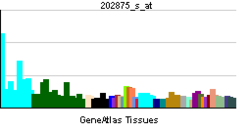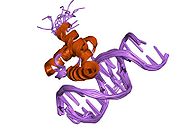- PBX2
-
Pre-B-cell leukemia transcription factor 2 is a protein that in humans is encoded by the PBX2 gene.[1][2]
This gene encodes a ubiquitously expressed member of the TALE/PBX homeobox family. It was identified by its similarity to a homeobox gene which is involved in t(1;19) translocation in acute pre-B-cell leukemias. This protein is a transcriptional activator which binds to the TLX1 promoter. The gene is located within the major histocompatibility complex (MHC) on chromosome 6.[2]
Contents
Interactions
PBX2 has been shown to interact with HOXA9.[3]
References
- ^ Sugaya K, Fukagawa T, Matsumoto K, Mita K, Takahashi E, Ando A, Inoko H, Ikemura T (Feb 1995). "Three genes in the human MHC class III region near the junction with the class II: gene for receptor of advanced glycosylation end products, PBX2 homeobox gene and a notch homolog, human counterpart of mouse mammary tumor gene int-3". Genomics 23 (2): 408–19. doi:10.1006/geno.1994.1517. PMID 7835890.
- ^ a b "Entrez Gene: PBX2 pre-B-cell leukemia homeobox 2". http://www.ncbi.nlm.nih.gov/sites/entrez?Db=gene&Cmd=ShowDetailView&TermToSearch=5089.
- ^ Shen, W F; Rozenfeld S, Kwong A, Köm ves L G, Lawrence H J, Largman C (Apr. 1999). "HOXA9 Forms Triple Complexes with PBX2 and MEIS1 in Myeloid Cells". Mol. Cell. Biol. (UNITED STATES) 19 (4): 3051–61. ISSN 0270-7306. PMC 84099. PMID 10082572. http://www.pubmedcentral.nih.gov/articlerender.fcgi?tool=pmcentrez&artid=84099.
Further reading
- Monica K, Galili N, Nourse J et al. (1991). "PBX2 and PBX3, new homeobox genes with extensive homology to the human proto-oncogene PBX1". Mol. Cell. Biol. 11 (12): 6149–57. PMC 361792. PMID 1682799. http://www.pubmedcentral.nih.gov/articlerender.fcgi?tool=pmcentrez&artid=361792.
- Aguado B, Campbell RD (1995). "The novel gene G17, located in the human major histocompatibility complex, encodes PBX2, a homeodomain-containing protein". Genomics 25 (3): 650–9. doi:10.1016/0888-7543(95)80007-9. PMID 7759099.
- Lu Q, Wright DD, Kamps MP (1994). "Fusion with E2A converts the Pbx1 homeodomain protein into a constitutive transcriptional activator in human leukemias carrying the t(1;19) translocation". Mol. Cell. Biol. 14 (6): 3938–48. PMC 358760. PMID 7910944. http://www.pubmedcentral.nih.gov/articlerender.fcgi?tool=pmcentrez&artid=358760.
- Katsanis N, Fitzgibbon J, Fisher EM (1996). "Paralogy mapping: identification of a region in the human MHC triplicated onto human chromosomes 1 and 9 allows the prediction and isolation of novel PBX and NOTCH loci". Genomics 35 (1): 101–8. doi:10.1006/geno.1996.0328. PMID 8661110.
- Berthelsen J, Zappavigna V, Mavilio F, Blasi F (1998). "Prep1, a novel functional partner of Pbx proteins". EMBO J. 17 (5): 1423–33. doi:10.1093/emboj/17.5.1423. PMC 1170490. PMID 9482739. http://www.pubmedcentral.nih.gov/articlerender.fcgi?tool=pmcentrez&artid=1170490.
- Shen WF, Rozenfeld S, Kwong A et al. (1999). "HOXA9 Forms Triple Complexes with PBX2 and MEIS1 in Myeloid Cells". Mol. Cell. Biol. 19 (4): 3051–61. PMC 84099. PMID 10082572. http://www.pubmedcentral.nih.gov/articlerender.fcgi?tool=pmcentrez&artid=84099.
- Fujino T, Yamazaki Y, Largaespada DA et al. (2001). "Inhibition of myeloid differentiation by Hoxa9, Hoxb8, and Meis homeobox genes". Exp. Hematol. 29 (7): 856–63. doi:10.1016/S0301-472X(01)00655-5. PMID 11438208.
- Brake RL, Kees UR, Watt PM (2002). "A complex containing PBX2 contributes to activation of the proto-oncogene HOX11". Biochem. Biophys. Res. Commun. 294 (1): 23–34. doi:10.1016/S0006-291X(02)00426-6. PMID 12054735.
- Strausberg RL, Feingold EA, Grouse LH et al. (2003). "Generation and initial analysis of more than 15,000 full-length human and mouse cDNA sequences". Proc. Natl. Acad. Sci. U.S.A. 99 (26): 16899–903. doi:10.1073/pnas.242603899. PMC 139241. PMID 12477932. http://www.pubmedcentral.nih.gov/articlerender.fcgi?tool=pmcentrez&artid=139241.
- Okada Y, Nagai R, Sato T et al. (2004). "Homeodomain proteins MEIS1 and PBXs regulate the lineage-specific transcription of the platelet factor 4 gene". Blood 101 (12): 4748–56. doi:10.1182/blood-2002-02-0380. PMID 12609849.
- Longobardi E, Blasi F (2003). "Overexpression of PREP-1 in F9 teratocarcinoma cells leads to a functionally relevant increase of PBX-2 by preventing its degradation". J. Biol. Chem. 278 (40): 39235–41. doi:10.1074/jbc.M304704200. PMID 12871956.
- Mungall AJ, Palmer SA, Sims SK et al. (2003). "The DNA sequence and analysis of human chromosome 6". Nature 425 (6960): 805–11. doi:10.1038/nature02055. PMID 14574404.
- Xie T, Rowen L, Aguado B et al. (2004). "Analysis of the Gene-Dense Major Histocompatibility Complex Class III Region and Its Comparison to Mouse". Genome Res. 13 (12): 2621–36. doi:10.1101/gr.1736803. PMC 403804. PMID 14656967. http://www.pubmedcentral.nih.gov/articlerender.fcgi?tool=pmcentrez&artid=403804.
- Lehner B, Semple JI, Brown SE et al. (2004). "Analysis of a high-throughput yeast two-hybrid system and its use to predict the function of intracellular proteins encoded within the human MHC class III region". Genomics 83 (1): 153–67. doi:10.1016/S0888-7543(03)00235-0. PMID 14667819.
- Gerhard DS, Wagner L, Feingold EA et al. (2004). "The Status, Quality, and Expansion of the NIH Full-Length cDNA Project: The Mammalian Gene Collection (MGC)". Genome Res. 14 (10B): 2121–7. doi:10.1101/gr.2596504. PMC 528928. PMID 15489334. http://www.pubmedcentral.nih.gov/articlerender.fcgi?tool=pmcentrez&artid=528928.
- Rual JF, Venkatesan K, Hao T et al. (2005). "Towards a proteome-scale map of the human protein-protein interaction network". Nature 437 (7062): 1173–8. doi:10.1038/nature04209. PMID 16189514.
- Kimura K, Wakamatsu A, Suzuki Y et al. (2006). "Diversification of transcriptional modulation: Large-scale identification and characterization of putative alternative promoters of human genes". Genome Res. 16 (1): 55–65. doi:10.1101/gr.4039406. PMC 1356129. PMID 16344560. http://www.pubmedcentral.nih.gov/articlerender.fcgi?tool=pmcentrez&artid=1356129.
PDB gallery 1b72: PBX1, HOMEOBOX PROTEIN HOX-B1/DNA TERNARY COMPLEX1b8i: STRUCTURE OF THE HOMEOTIC UBX/EXD/DNA TERNARY COMPLEX1du6: SOLUTION STRUCTURE OF THE TRUNCATED PBX HOMEODOMAIN1lfu: NMR Solution Stucture of the Extended PBX Homeodomain Bound to DNA1puf: Crystal Structure of HoxA9 and Pbx1 homeodomains bound to DNAExternal links
This article incorporates text from the United States National Library of Medicine, which is in the public domain.
Transcription factors and intracellular receptors (1) Basic domains (1.1) Basic leucine zipper (bZIP)Activating transcription factor (AATF, 1, 2, 3, 4, 5, 6, 7) · AP-1 (c-Fos, FOSB, FOSL1, FOSL2, JDP2, c-Jun, JUNB, JUND) · BACH (1, 2) · BATF · BLZF1 · C/EBP (α, β, γ, δ, ε, ζ) · CREB (1, 3, L1) · CREM · DBP · DDIT3 · GABPA · HLF · MAF (B, F, G, K) · NFE (2, L1, L2, L3) · NFIL3 · NRL · NRF (1, 2, 3) · XBP1(1.2) Basic helix-loop-helix (bHLH)ATOH1 · AhR · AHRR · ARNT · ASCL1 · BHLHB2 · BMAL (ARNTL, ARNTL2) · CLOCK · EPAS1 · FIGLA · HAND (1, 2) · HES (5, 6) · HEY (1, 2, L) · HES1 · HIF (1A, 3A) · ID (1, 2, 3, 4) · LYL1 · MESP2 · MXD4 · MYCL1 · MYCN · Myogenic regulatory factors (MyoD, Myogenin, MYF5, MYF6) · Neurogenins (1, 2, 3) · NeuroD (1, 2) · NPAS (1, 2, 3) · OLIG (1, 2) · Pho4 · Scleraxis · SIM (1, 2) · TAL (1, 2) · Twist · USF1(1.3) bHLH-ZIP(1.4) NF-1(1.5) RF-X(1.6) Basic helix-span-helix (bHSH)(2) Zinc finger DNA-binding domains (2.1) Nuclear receptor (Cys4)subfamily 1 (Thyroid hormone (α, β), CAR, FXR, LXR (α, β), PPAR (α, β/δ, γ), PXR, RAR (α, β, γ), ROR (α, β, γ), Rev-ErbA (α, β), VDR)
subfamily 2 (COUP-TF (I, II), Ear-2, HNF4 (α, γ), PNR, RXR (α, β, γ), Testicular receptor (2, 4), TLX)
subfamily 3 (Steroid hormone (Androgen, Estrogen (α, β), Glucocorticoid, Mineralocorticoid, Progesterone), Estrogen related (α, β, γ))
subfamily 4 NUR (NGFIB, NOR1, NURR1) · subfamily 5 (LRH-1, SF1) · subfamily 6 (GCNF) · subfamily 0 (DAX1, SHP)(2.2) Other Cys4(2.3) Cys2His2General transcription factors (TFIIA, TFIIB, TFIID, TFIIE (1, 2), TFIIF (1, 2), TFIIH (1, 2, 4, 2I, 3A, 3C1, 3C2))
ATBF1 · BCL (6, 11A, 11B) · CTCF · E4F1 · EGR (1, 2, 3, 4) · ERV3 · GFI1 · GLI-Krüppel family (1, 2, 3, REST, S2, YY1) · HIC (1, 2) · HIVEP (1, 2, 3) · IKZF (1, 2, 3) · ILF (2, 3) · KLF (2, 3, 4, 5, 6, 7, 8, 9, 10, 11, 12, 13, 14, 15, 17) · MTF1 · MYT1 · OSR1 · PRDM9 · SALL (1, 2, 3, 4) · SP (1, 2, 4, 7, 8) · TSHZ3 · WT1 · Zbtb7 (7A, 7B) · ZBTB (16, 17, 20, 32, 33, 40) · zinc finger (3, 7, 9, 10, 19, 22, 24, 33B, 34, 35, 41, 43, 44, 51, 74, 143, 146, 148, 165, 202, 217, 219, 238, 239, 259, 267, 268, 281, 295, 300, 318, 330, 346, 350, 365, 366, 384, 423, 451, 452, 471, 593, 638, 644, 649, 655)(2.4) Cys6(2.5) Alternating composition(3) Helix-turn-helix domains (3.1) HomeodomainARX · CDX (1, 2) · CRX · CUTL1 · DBX (1, 2) · DLX (3, 4, 5) · EMX2 · EN (1, 2) · FHL (1, 2, 3) · HESX1 · HHEX · HLX · Homeobox (A1, A2, A3, A4, A5, A7, A9, A10, A11, A13, B1, B2, B3, B4, B5, B6, B7, B8, B9, B13, C4, C5, C6, C8, C9, C10, C11, C12, C13, D1, D3, D4, D8, D9, D10, D11, D12, D13) · HOPX · IRX (1, 2, 3, 4, 5, 6, MKX) · LMX (1A, 1B) · MEIS (1, 2) · MEOX2 · MNX1 · MSX (1, 2) · NANOG · NKX (2-1, 2-2, 2-3, 2-5, 3-1, 3-2, 6-1, 6-2) · NOBOX · PBX (1, 2, 3) · PHF (1, 3, 6, 8, 10, 16, 17, 20, 21A) · PHOX (2A, 2B) · PITX (1, 2, 3) · POU domain (PIT-1, BRN-3: A, B, C, Octamer transcription factor: 1, 2, 3/4, 6, 7, 11) · OTX (1, 2) · PDX1 · SATB2 · SHOX2 · VAX1 · ZEB (1, 2)(3.2) Paired box(3.3) Fork head / winged helix(3.4) Heat Shock Factors(3.5) Tryptophan clusters(3.6) TEA domain(4) β-Scaffold factors with minor groove contacts (4.1) Rel homology region(4.2) STAT(4.3) p53(4.4) MADS box(4.6) TATA binding proteins(4.7) High-mobility group(4.10) Cold-shock domainCSDA, YBX1(4.11) Runt(0) Other transcription factors (0.2) HMGI(Y)(0.3) Pocket domain(0.6) Miscellaneoussee also transcription factor/coregulator deficiencies
B bsyn: dna (repl, cycl, reco, repr) · tscr (fact, tcrg, nucl, rnat, rept, ptts) · tltn (risu, pttl, nexn) · dnab, rnab/runp · stru (domn, 1°, 2°, 3°, 4°)Categories:- Human proteins
- Chromosome 6 gene stubs
- Transcription factors
Wikimedia Foundation. 2010.









